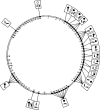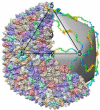Bacteriophage assembly
- PMID: 21994726
- PMCID: PMC3185693
- DOI: 10.3390/v3030172
Bacteriophage assembly
Abstract
Bacteriophages have been a model system to study assembly processes for over half a century. Formation of infectious phage particles involves specific protein-protein and protein-nucleic acid interactions, as well as large conformational changes of assembly precursors. The sequence and molecular mechanisms of phage assembly have been elucidated by a variety of methods. Differences and similarities of assembly processes in several different groups of bacteriophages are discussed in this review. The general principles of phage assembly are applicable to many macromolecular complexes.
Keywords: assembly; bacteriophage; genome packaging; macromolecular complex; maturation.
Figures






References
-
- Wood WB, Edgar RS, King J, Lielausis I, Henninger M. Bacteriophage assembly. Fed. Proc. 1968;27:1160–1166. - PubMed
-
- Casjens S, King J. Virus assembly. Annu. Rev. Biochem. 1975;44:555–611. - PubMed
-
- Bazinet C, King J. The DNA translocating vertex of dsDNA bacteriophage. Annu. Rev. Microbiol. 1985;39:109–129. - PubMed
-
- Black LW. DNA packaging in dsDNA bacteriophages. Annu. Rev. Microbiol. 1989;43:267–292. - PubMed
Publication types
MeSH terms
Substances
Grants and funding
LinkOut - more resources
Full Text Sources

